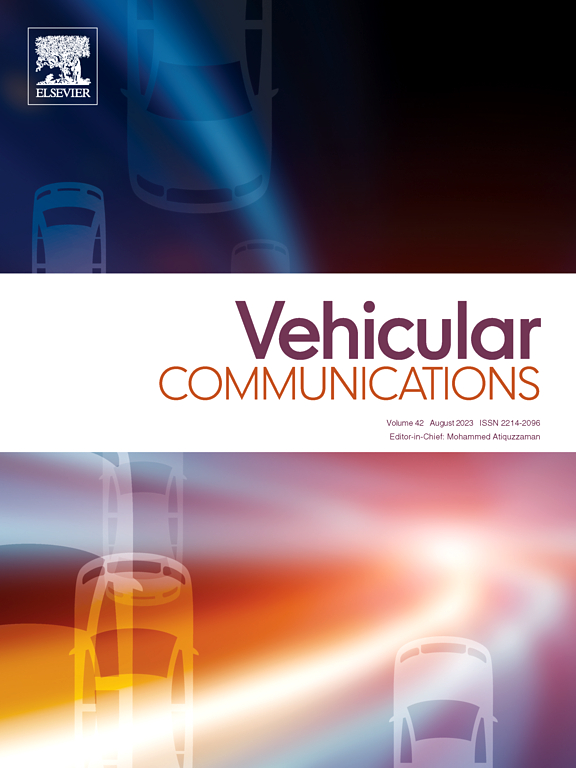5G NR sidelink time domain based resource allocation in C-V2X
IF 6.5
2区 计算机科学
Q1 TELECOMMUNICATIONS
引用次数: 0
Abstract
This study explores the need for efficient resource allocation in fifth generation (5G) New Radio (NR) sidelink communication for cellular vehicle-to-everything (C-V2X) applications. With the advent of 5G networks, C-V2X can enable direct connection between neighboring vehicles and infrastructure without relying on the cellular network. However, direct communication between devices in 5G NR sidelink makes resource allocation more challenging than in a cellular network. Efficient resource allocation is essential to maintain dependable communication, especially in crowded and interference-prone contexts. There are different type of resource allocation methods such as time-domain, frequency-domain, and power-domain resource allocation, which can be used separately or in combination to achieve efficient resource allocation. In this study, the authors discuss time domain based resource allocation method based on packet generation time and packet allocation time. The implications of efficient resource allocation in 5G NR sidelink in C-V2X include increased signal-to-noise ratio, reduced interference, lower latency, and increased network capacity. The proposed approach is demonstrated on a Network Simulator (NS3.34) along with the traffic scenarios generated using Simulated Urban Mobility (SUMO). Our results demonstrate that time allocation is a promising approach to achieve efficient resource allocation, enabling safer and more effective transportation systems for C-V2X applications.
基于5G NR副链路时域的C-V2X资源分配
本研究探讨了蜂窝车对万物(C-V2X)应用中第五代(5G)新无线电(NR)副链路通信对有效资源分配的需求。随着5G网络的出现,C-V2X可以在不依赖蜂窝网络的情况下实现相邻车辆和基础设施之间的直接连接。然而,在5G NR副链路中,设备之间的直接通信使得资源分配比在蜂窝网络中更具挑战性。有效的资源分配对于保持可靠的通信至关重要,特别是在拥挤和易受干扰的环境中。资源分配方法有时域、频域、功率域等,可以单独使用,也可以结合使用,以实现高效的资源分配。在本研究中,作者讨论了基于包生成时间和包分配时间的时域资源分配方法。C-V2X中5G NR副链路的有效资源分配包括提高信噪比、减少干扰、降低延迟和增加网络容量。所提出的方法在网络模拟器(NS3.34)上进行了演示,并使用模拟城市交通(SUMO)生成了交通场景。我们的研究结果表明,时间分配是一种很有前途的方法,可以实现有效的资源分配,为C-V2X应用提供更安全、更有效的交通系统。
本文章由计算机程序翻译,如有差异,请以英文原文为准。
求助全文
约1分钟内获得全文
求助全文
来源期刊

Vehicular Communications
Engineering-Electrical and Electronic Engineering
CiteScore
12.70
自引率
10.40%
发文量
88
审稿时长
62 days
期刊介绍:
Vehicular communications is a growing area of communications between vehicles and including roadside communication infrastructure. Advances in wireless communications are making possible sharing of information through real time communications between vehicles and infrastructure. This has led to applications to increase safety of vehicles and communication between passengers and the Internet. Standardization efforts on vehicular communication are also underway to make vehicular transportation safer, greener and easier.
The aim of the journal is to publish high quality peer–reviewed papers in the area of vehicular communications. The scope encompasses all types of communications involving vehicles, including vehicle–to–vehicle and vehicle–to–infrastructure. The scope includes (but not limited to) the following topics related to vehicular communications:
Vehicle to vehicle and vehicle to infrastructure communications
Channel modelling, modulating and coding
Congestion Control and scalability issues
Protocol design, testing and verification
Routing in vehicular networks
Security issues and countermeasures
Deployment and field testing
Reducing energy consumption and enhancing safety of vehicles
Wireless in–car networks
Data collection and dissemination methods
Mobility and handover issues
Safety and driver assistance applications
UAV
Underwater communications
Autonomous cooperative driving
Social networks
Internet of vehicles
Standardization of protocols.
 求助内容:
求助内容: 应助结果提醒方式:
应助结果提醒方式:


